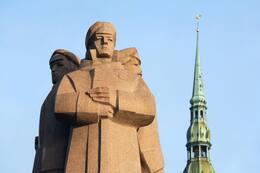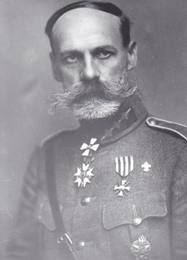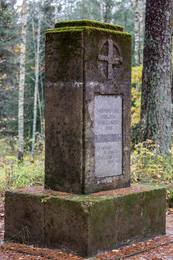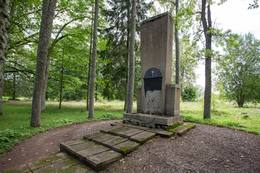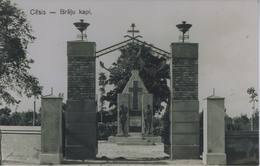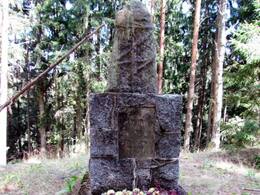Latvijos raudonieji šauliai
I WW1, I Nepriklausomybės karai
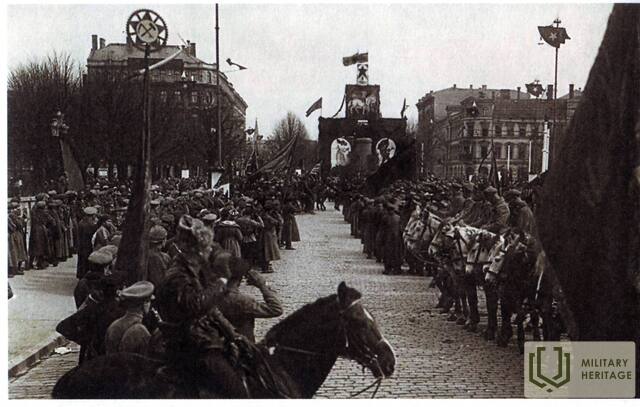
Terminas „raudonieji šauliai“ atsirado per Rusijos pilietinį karą 1918 m., siejant latvių šaulių dalinius su „raudonąja gvardija“, Rusijos „raudonąja armija“, o apibendrintas terminas „raudonieji“, kuris buvo taikomas bolševikų (vėliau komunistų) rėmėjams.
Prasidėjus Pirmajam pasauliniam karui Latvijos teritoriją pamažu užėmė vokiečių kariuomenė, prasidėjo platus pabėgėlių judėjimas. 1915 m. vasarą rusų kariuomenė patyrė sunkių pralaimėjimų, o Kuršą, Žiemgalą ir dalį Sēlijos užėmė vokiečiai. Latvių iniciatyva formuoti tautinius dalinius buvo vienas iš nedaugelio šiaudo, prie kurio galėjo prikibti nesėkmių kamuojama Rusijos kariuomenė. 1915 m. rugpjūčio 10 d. spaudoje buvo paskelbtas rašytojų K. Skalbės ir A. Ķeninio parašytas kreipimasis į Latvijos žmones dėl nacionalinių karinių dalinių kūrimo, pasirašytas Rusijos Valstybės Dūmos deputatų Jānio Goldmanio ir Jānio Zālīčio. Iš viso užsiregistravo apie 8000 savanorių, o per Pirmąjį pasaulinį karą latvių šaulių batalionuose buvo iki 25 000 vyrų.
1917 m. bolševizmo idėjos sparčiai plito tarp latvių, kuriuos karas nuvarė į neviltį. Didžiųjų vyrų šūkiai apie taiką, žemę ir duoną buvo labai populiarūs karo išvargintoje Latvijos visuomenėje. Didikų įtaka išaugo ir tarp lankininkų, kurie ankstesnėse žiemos kovose patyrė beprasmius ir didelius nuostolius.
1917 metų rudenį, pasinaudoję Rusijos kariuomenės kovinių pajėgumų nuosmukiu, vokiečiai užėmė Rygą, o 1918 metų vasarį – visą Vidžemę ir Latgalą. Nemažai šaulių pasidavė vokiečiams arba tiesiog dezertyravo iš savo dalinių pasilikti Vidžemėje. Didikai ir ištikimiausia šaulių dalis pabėgo į Rusiją. 1918 m. balandžio 13 d. Maskvoje buvo suformuota latvių šaulių sovietų divizija.
Latvijos raudonųjų šaulių daliniai buvo naudojami apsaugoti Rusijos sovietų vyriausybę ir aukštus pareigūnus, užsienio šalių ambasadas, palaikyti tvarką didžiausiuose Rusijos miestuose, malšinti valstiečių ir darbininkų sukilimus, kovoti su politiniais bolševikų priešininkais per Rusijos pilietinį karą 1918–1920 m.
Sudarius taikos sutartį tarp Rusijos ir Latvijos, 1921 metų vasarą iš Sovietų Rusijos grįžo 11 395 buvę „raudonieji“ latvių šauliai. Dalis vadovaujančio štabo liko Sovietų Rusijoje ir padarė sėkmingą karinę karjerą. Dauguma buvusių šaulių žuvo 1937-1938 m. dėl didelių Stalino represijų 1945 m.
Daugiau informacijos šaltinių
1. Sielų pūga. Skaitmeninis muziejus. Prieiga ].
2. Šiliņš J. „Latvių raudonieji šauliai“. Nacionalinė enciklopedija. Prieiga: https://enciklopedija.lv/skirklis/36374-latviešu-sarkanie-strēlnieki [žiūrėta 2021 05 08.].
3. Vējiņš J. Latvija - likimo vagoje 1918 – 1991, Spaudos rūmai, 2007 m.
Susijusi laiko juosta
Susijusios vietos
Latvian Riflemen Monument in Riga
It is located in the center of Riga, in the Latvian Riflemen's Square near the Latvian Occupation Museum.
The monument to the Latvian archers was opened in 1971 at the Latvian Archers Square next to the former Latvian Red Archers Museum (tag: Occupation Museum). During the Soviet era, the topic was viewed through a narrow prism of the communist regime's ideology. The place served to represent Riga and create an idealized story, strengthening the myth of Latvians as fighters of the Soviet power.
Light infantry units in the Russian army were called archers. In World War 1, Latvian riflemen formations were created to fight against the German army in the homeland. They were motivated, dangerous and disciplined fighting units. The high level of education and German language skills were useful for reconnaissance and surprise attacks. When the Russian Empire collapsed and Germany completely occupied the territory of Latvia, a very large number of Latvian residents went to Russia, where they continued to face the agitation of bigots. Initially, support for Lenin's ideas and participation in the Russian Civil War grew. Disappointment followed later, and most Latvian soldiers turned away from leftist ideas and returned to Latvia. The soldiers who remained in Russia were mostly killed in "Stalin's purges" (1936-1938). Latvian archers had great merits in the creation of the Latvian state and its army.
Today you can see the monument and the adjacent Museum of Occupation.
General Karl Gopper Memorial Room in the Muscat Hometown
Located in Plāņi Parish on the bank of the Vija River.
The memorial room of General Karl Gopper in his native house "Muscat" can be seen.
The Muscat farm was run by the general's brother, August Goppers, because the talented warlord was busy with major events and world wars. In 1920, the general returned to Latvia, to his native home. But many responsible duties connected him with Riga. August continued to operate in Muscat. In 1940, General Gopper was arrested and shot on March 25, 1941, in a check cellar. In 1944, the Gopper family went to Kurzeme as refugees with three horse-drawn carriages. The war divided the family, Alexander Gopper's daughters - Biruta, Elza and Anna - remained in Latvia. They were not allowed to return to Muscat. The houses were large and carefully maintained. Three four newcomer families were accommodated in separate rooms. A horse farm was set up in the big barn. A fire broke out in 1980 due to mutual scabies. The barn and the big barn burned down. Fortunately, the fire did not spread to the house, the flames were repelled by large trees planted by our ancestors.
In 1991, after the miraculous Awakening, the Latvian state was reborn for the second time. In 1992, the family of General Gopper's brother Augustus regained Muscat as an ancestral sanctity. For ten years, all the cheeses worked hard to save the houses from destruction, to restore and build the ruined buildings to make the entire Muscat farm beautiful. The houses have been restored to their old appearance, there is also a memorial room for General Karl Gopper. The memorial room can be visited in advance by calling +371 29396870, +371 29254285.
Excursion to the monument to the soldiers who died in the First World War in the park of Spāre manor
Located in the territory of the Spāre manor complex.
During the First World War, the Russian Army Field Infirmary was located in Spāre Manor. The 24 soldiers who died there, including Latvian riflemen, were buried in the nearby cemetery. The monument was unveiled on October 6, 1935.
Rows of lindens were planted on both sides of the road during the memorial site (starting from the road). In 1935, all the improvement works in the area were carried out by the students of Spāre under the guidance of the school administrator Kārlis and Alvīne Skalbergs.
The pupils of Spāre Primary School in Amata Region are also involved in the cleaning of the memorial site. The land guards of Cēsis 27. KB provide great support in these works.
A torchlight procession to the memorial to the fallen in World War I, which is being held on 11 November, has become a tradition. This event is always crowded by the guards of Cēsis 27. KB, there is always a chaplain with them. Festive halls are an integral part of the event.
In the territory of the Spāre manor complex, an excursion to the monument to the soldiers who fell in the First World War (45 min.) Is offered by prior arrangement by calling +371 26558464.
Monument to the soldiers who died in the First World War and the Latvian War of Independence
Located on Baznīcas Street opposite St. Anne's Church.
A monument to the soldiers who died in the First World War and the Latvian War of Independence can be seen.
On May 1, 1923, a "Hero's Grove" was planted opposite the Mazsalaca Lutheran Church, where an oak tree was dedicated to each fallen. According to Likert, a total of 97 oaks were planted - 23 for the fallen in the War of Independence and 74 for the fallen in the First World War. However, the press at the time mentioned that 106 oaks had been planted.
On August 21, 1927, a concrete monument built by architect Pauls Kundziņš was unveiled in the Heroes' Square, in the construction of which the sculptor Vilhelms Treijs also participated.
The monument is located next to the church of St. Anne in Mazsalaca, which was built in a specially designated place to slide (58.6 m), the beautiful tower can be seen from afar. The church is well preserved, as it was neither destroyed nor adapted for any other use during the Soviet era.
Cesis Brothers Cemetery
Located in Cēsis Lejas Cemetery, Lenču Street 15, Cēsis.
One of the most important memorial sites of the First World War and the War of Independence in Cēsis is the Brothers' Cemetery in the Lower Cemetery.
The cemetery is the monument of the Brethren's Cemetery, built in 1927 by the artist and thinker of Cēsis Augustus Julla (1872-1958), dedicated to the soldiers buried in the Brothers' Cemetery from 1915 to 1920.
About 200 soldiers are buried in the Brothers Cemetery of Cēsis Lower Cemetery. Among them, an unknown number of Latvian riflemen and Russian soldiers killed in the First World War, as well as soldiers of German (10), Polish and other nationalities. During the Latvian Liberation War, 22 fallen soldiers of the 5th (2nd) Cēsis Infantry Regiment, as well as 11 freedom fighters who fell in other Latvian army units, were buried in these cemeteries. 2 Estonians, 15 victims of Bolsheviks and also Latvian Red Riflemen are buried in the Brothers' Cemetery.
Krači Mountains Monument
The Krāči Hills are one of the largest coastal dunes of the Litorina Sea. Its highest point is 29 m above sea level and 26 m above the surrounding plains. The Litorina Sea is said to be the predecessor of the Baltic Sea, which existed approximately 7,000 to 5,000 years ago.
The 6th Special Brigade of the 12th Russian Army launched the attack from the Krāči Hills during the Christmas Battles, with the task of breaking through the German front from the Great Tīreļi Swamp to the Lielupe River. During the month-long battles, the Russian army gained an area of 25 square kilometers, but the losses were enormous – 45 thousand fallen, wounded and missing soldiers. The losses of the Latvian riflemen were 9 thousand fallen, wounded and missing soldiers. During the Christmas Battles, the Latvian riflemen gained immense fame as heroic and brilliant soldiers, paying a very high price for it – their lives.
A monument has been erected in memory of those who fell in battle. Every year on November 11, Lāčplēsis Day, and on November 18, the anniversary of the proclamation of the Latvian state, candles are lit at this place in memory of the fallen heroes.
The protected nature area "Krāči Mountains" as a dune mound of the Litorina period
Susijusi istorija
Anšlavo Eglītio prisiminimai apie Latvijos nepriklausomybės karą ir 1919 metų įvykius Alūksnėje
1919 m. kovo 27 d. 1-asis Valmieros pėstininkų pulkas kartu su Estijos gvardijos (kaitselit) Talino (tuomet Rėvelės) ir Tērbato batalionais bei trimis šarvuotaisiais traukiniais nuo Melnupės upės krantų pradėjo Latvijos išvadavimą nuo bolševikų.
Apie generolą Karlį Goppersą
Generolas K. Goppersas (1876-1941) buvo puikus karys ir puikus žmogus. Pasižymėjo kaip sėkmingas vadas, vadovavęs batalionams ir pulkams, didvyriškai vadovavęs savo šauliams kovose už Latvijos laisvę Pirmojo pasaulinio karo metais (1914–1919). Dalyvavo mūšiuose Tīrelpurvoje, Ložmetējkalnyje, Rygos gynyboje.
Prisiminimai apie Karo muziejaus kūrimo pradžią
Pasakotojas aprašo aplinkybes, kuriomis buvo įkurtas Karo muziejus. Minėtos problemos ir surinkimo darbai.
Negos upės tilto išgelbėjimas nuo susprogdinimo
Tuo metu, kai 1944 m. vokiečiai traukėsi, buvo susprogdinta daug svarbių objektų ir to išvengti buvo labai sunku, tačiau pasakojama ir apie stebuklingus nutikimus, kai vietos gyventojų drąsa ir kario tolerancija leido išsaugoti vietos gyventojams svarbias vietas, lašiša išliko gyva. Viena iš istorijų yra ši apie diskusiją tarp namų šeimininkės ir vokiečių kareivio, kuris išgelbėjo nuo susprogdinimo visą tiltą.






